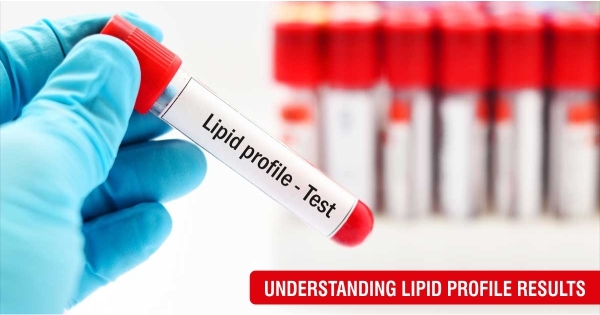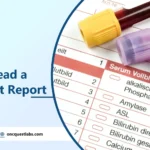Contents
What is the Lipid Profile Test?
A complete cholesterol test, also known as Lipid Profile Test/ Lipid Panel, is a blood test used for assessing the risk of developing a Cardiovascular disease (CVD). This can be done by measuring the amount and type of lipids (fats) present in the blood.
The test assesses the levels of:
- Total Cholesterol: The total amount of cholesterol present in the bloodstream.
- Low-Density Lipoprotein (LDL) Cholesterol: LDL cholesterol level in the blood.
- High-Density Lipoprotein (HDL) Cholesterol: HDL cholesterol level in the blood.
- Triglycerides: This is a type of fat stored in the fat cells of the body. These cells can also contribute to the narrowing of the artery walls.
What is Cholesterol?
Cholesterol is a waxy substance present in the blood which is produced naturally by the liver. It is essential for the formation of cell membranes, specific hormones, and Vitamin D.
Cholesterol is carried in the bloodstream by proteins. When cholesterol and proteins both combine, they are known as Lipoproteins.
Where Does Cholesterol Come from?
Cholesterol is produced by your body and comes from the foods you eat, and it plays a significant role in maintaining the health of your cells in your body.
There are two types of cholesterol:
Low-Density Lipoproteins (LDL): considered the “bad” cholesterol. It contributes to fatty buildups in arteries. If LDL cholesterol is too high, it can build up on the walls of the arteries, also known as cholesterol plaque.
High cholesterol can result in various complications such as:
- Chest pain
- Heart attack
- Stroke
- High Blood Pressure
- Peripheral Vascular Disease
- Chronic Kidney Disease
High-Density Lipoproteins (HDL): often called “good” cholesterol because a healthy level may protect against heart attack and stroke. It absorbs cholesterol and carries it back to the liver. The liver then flushes it from the body.
However, Triglycerides are another fat that doctors measure with cholesterol testing. High levels may raise your chances of having a heart attack or stroke.
This is especially true when you have low “good” cholesterol levels, called high-density lipoprotein (HDL). High triglyceride levels also make you more likely to develop diabetes.
How to interpret the results of a Lipid Profile Test?
The doctor uses the lipid profile results to assess the risk of heart disease and develop a treatment plan accordingly. These test results can also help monitor the effectiveness of the treatment plan. The treatment plan may involve lifestyle changes such as food, exercise, or medications.
Cholesterol levels are measured in milligrams (mg) of cholesterol per deciliter (dL) of blood.
These are the ideal results of cholesterol levels for most adults:
- LDL (Bad Cholesterol): 70 to 130 mg/dL, the lower, the better.
- HDL (Good Cholesterol): 40 to 60 mg/dL, the higher, the better.
- Total cholesterol: less than 200 mg/dL, the lower, the better.
- Triglycerides: 10 to 150 mg/dL, the lower, the better.
What are the Causes of High Cholesterol?
Following factors may be responsible for developing high cholesterol:
- A diet high in saturated fat
- Smoking
- Drinking more alcohol than recommended levels
- Not being physically active.
- Family history of high cholesterol, heart disease, or a stroke
- Genetic factors such as familial hypercholesterolemia
Your overall health and other health problems can have an effect too, including:
- Type 2 Diabetes
- Chronic kidney disease
- Liver disease
- Polycystic ovary syndrome
- Pregnancy
- Underactive thyroid gland
- HIV
- Inflammatory diseases such as psoriasis, rheumatoid arthritis.
- Certain medications such as Diuretics, Steroids, Antiretroviral medicines, Immunosuppressive drugs, etc.
What are the tips to prevent High Cholesterol?
The good news is that you can take steps and make lifestyle changes to lower your cholesterol. You also reduce your risk of other illnesses or help stop them from getting worse by lowering your cholesterol.
Lifestyle changes can help prevent high cholesterol. The following tips may help:
- Cut down on fatty food, especially food that contains saturated fats and trans fats such as red meat, organ meats, egg yolks, and high-fat dairy products
- Try to eat more nuts and seeds, fruits and vegetables, whole grains, and legumes.
- Exercise more, aim to do at least 150 minutes of exercise a week.
- Stop smoking
- Maintain a healthy weight
- Cut down on alcohol
- Manage stress. Chronic stress can sometimes increase LDL cholesterol levels and decrease HDL cholesterol levels.
Disclaimer:
This blog is for informational purposes only and should not be construed as advice or as a substitute for consulting a physician. It is not a substitute for medical advice or treatment from a healthcare professional.
Sources:
Cholesterol Testing and the Lipid Panel – Treatment Options for Abnormal Lipid Levels





